Celebrate spring with this lighter, brighter, but just as luxurious version of Pasta Primavera. Incredibly simple and quick to make, this veggie-loaded pasta dish makes an elegant, yet family friendly meal.
The first thing you need to know about this pasta dish is that the pasta plays a background role to all the gorgeous spring vegetables. Flavoured with a simple and light sauce made with smashed garlic, lemon zest, lemon juice and just a smidge of heavy cream, the dish is so bright and fresh it just screams spring.
Fresh basil, chives, and a generous shower of parmesan to finish, makes this the only dish I want to eat on a warm spring or summer evening. I know you’ll love it too.
Pasta Primavera Recipe
Primavera means spring in Italian (and Spanish). In the mid ’70’s, chef Sirio Maccioni thought to combine spring vegetables and pasta with a creamy sauce and called it pasta primavera – “spring pasta”. He served it at his famous New York restaurant Le Cirque where it quickly became known as “the best pasta in town”. Many other Italian-American restaurants across the country jumped on the infamous pasta dish and offered their own variation.
A few decades later, like most trendy dishes, pasta primavera eventually lost its appeal. If interested, this is a great read about the rise and fall of pasta primavera.
Perhaps the biggest drawback of the original pasta primavera, was that it was made with too much cream. Though sadly I never tasted the dish from Le Cirque, an Alfredo-like sauce would be the last thing I’d want to mix in with fresh and bright spring vegetables. So for this version of pasta primavera, we are using only a very small amount of cream. Mixed with the starchy pasta water and lemon juice, it creates a delicate, silky sauce that truly allows the vegetables to shine.
A quick google search will show you pasta primavera has made a comeback in many restaurants and home kitchens. For good reason. Quick and easy to make, it’s a delicious pasta dish and a great way to load up on veggies. You can use any vegetables you like, but with the exception of cherry tomatoes, I take the name of the dish to heart and stick to mostly seasonal, spring vegetables.
Ingredients And Notes
Yes, you can make pasta primavera any time of year with any vegetables you like. But make it once with mostly green, fresh spring produce and it may spoil for life to make it any other way.
- Pasta – The classic pasta primavera was made with spaghetti or angel hair noodles. But because the dish has so many chopped vegetables, I find it more enjoyable with a short pasta. Penne, farfalle (bowtie), shells, rotini, etc, are all great choices. If I was going to use a long noodle I would likely choose a fresh egg pasta such as tagliatelle or linguini.
- Extra-virgin olive oil – Because the sauce in this pasta primavera uses very little cream, we use a generous amount of olive oil to keep things flavourful and saucy.
- Garlic – Though I absolutely adore garlic, I didn’t want a strong garlic flavour in this dish. Instead, whole crushed garlic cloves lightly flavour the olive oil, which are then discarded towards the end.
- Lemon zest and juice – Both the zest and juice of a lemon are essential here. Their juicy tart flavour adds a lot of brightness to the dish.
- Heavy cream – We are only using a 1/4 cup of heavy cream here to keep things light. You can use crème fraîche or a few tablespoons of butter, if you prefer. If avoiding dairy you can replace with more olive oil and a bit more pasta water.
- Herbs – I use basil and chives to sprinkle over the finished dish. Parsley or tarragon would also work.
- Spring vegetables – Here I used asparagus, peas, sugar snap peas, green onions, and zucchini. I know technically zucchini is not a spring vegetable but it will be available soon for summer and I love it in pasta, so I included it. Other great choices would be broccolini, fava beans, fiddleheads, or snow peas. If you don’t have green onions, shallots would also be delicious.
- Cherry tomatoes – Again, not a spring vegetable but their tangy acidity is a nice complement to all the earthy green vegetables.
- Parmesan – Unsurprisingly, your pasta primavera will taste a gazillion times better when tossed with a generous amount of Parmigiano-Reggiano. You can also use Grana Padano or Pecorino cheese.
Note: Fresh peas were not available just yet where I live so I had to use frozen. Once fresh peas explode in the market, that is all I will use in this pasta primavera.
How To Make Pasta Primavera
- Bring a large pot of heavily salted water to a boil over high heat.
- While the water is coming to a boil, heat oil in a large skillet over medium heat. Add garlic and cook until very fragrant and just starting to brown on both sides, about 2 to 3 minutes. Stir in the asparagus, snap peas and zucchini and add a 1/2 cup of the boiling pasta water. Cover skillet and cook until vegetables are barely tender, about 3 minutes. (If your skillet doesn’t have a lid, add another 1/4 cup of water and cook for 2 minutes longer).
- Remove the garlic, and stir in the green onions, cherry tomatoes, peas and heavy cream. Season with salt and pepper; set aside.
- Meanwhile, cook the pasta just until al dente (about 2 to 3 minutes less than the package instructions). Reserve about 1 cup pasta water, and drain well. Transfer pasta to the skillet and toss to coat, adding a few splashes of pasta water as needed ( I usually add about 1/2 cup).
- Remove skillet from heat and stir in Parmigiano-Reggiano and herbs. Taste and season with a bit more salt and pepper, if needed. Serve immediately passing more parmesan around at the table.
Tips
- Cut vegetables to similar size. Larger vegetables should be cut down to a size where they will cook quickly. I like to trim them to about 1-inch pieces.
- Add smaller, more tender vegetables towards the end. Smaller, more tender vegetables such as peas and zucchini should be added towards the end. Otherwise, they will overcook.
- Cook the pasta just to al-dente. The pasta will continue to cook when tossed with the veggies so make sure to cook it for 2 to 3 minutes less than the package instructs.
- Add some chicken or shrimp. I almost always keep my pasta primavera vegetarian but some sautéed chicken breast or shrimp would be a great addition to this dish.
- Season well. Always season a pasta dish with enough salt for the best flavour. You can also give it a good pinch of crushed red peppers, if you wish.
To Serve
Loaded with veggies, pasta primavera makes a filling and satisfying meal all on its own. If you do need a side, a caprese salad, this outrageously good Italian salad, crostini with bruschetta, or this gorgeous panzanella salad, would all pair beautifully with pasta primavera.
If you’d like to pair it with a side of meat, I would recommend this grilled chicken, a roasted chicken, grilled fish, or shrimp skewers.
Leftovers And Storage
Leftovers of pasta primavera make great lunches. That said, the softer veggies (peas, zucchini, etc) will get a bit mushy when reheated so I sometimes eat it cold or barely reheated—still delish.
To store: Once cooled, transfer pasta to an air-tight container and refrigerate for up to 4 days. To reheat, place the pasta primavera along with a splash of water in a saucepan. Cook over medium heat on the stovetop, until warmed through.
More Pasta Recipes To Try
- One-pan Pasta
- Pasta Puttanesca
- Pasta with Grilled Zucchini and Summer Squash
- Kale Sauce Pasta with Burrata and Peas
If you give this Pasta Puttanesca recipe a try, please feel free to leave a comment and/or a star rating below. We appreciate and welcome all your feedback. Thank you!
Pasta Primavera Recipe
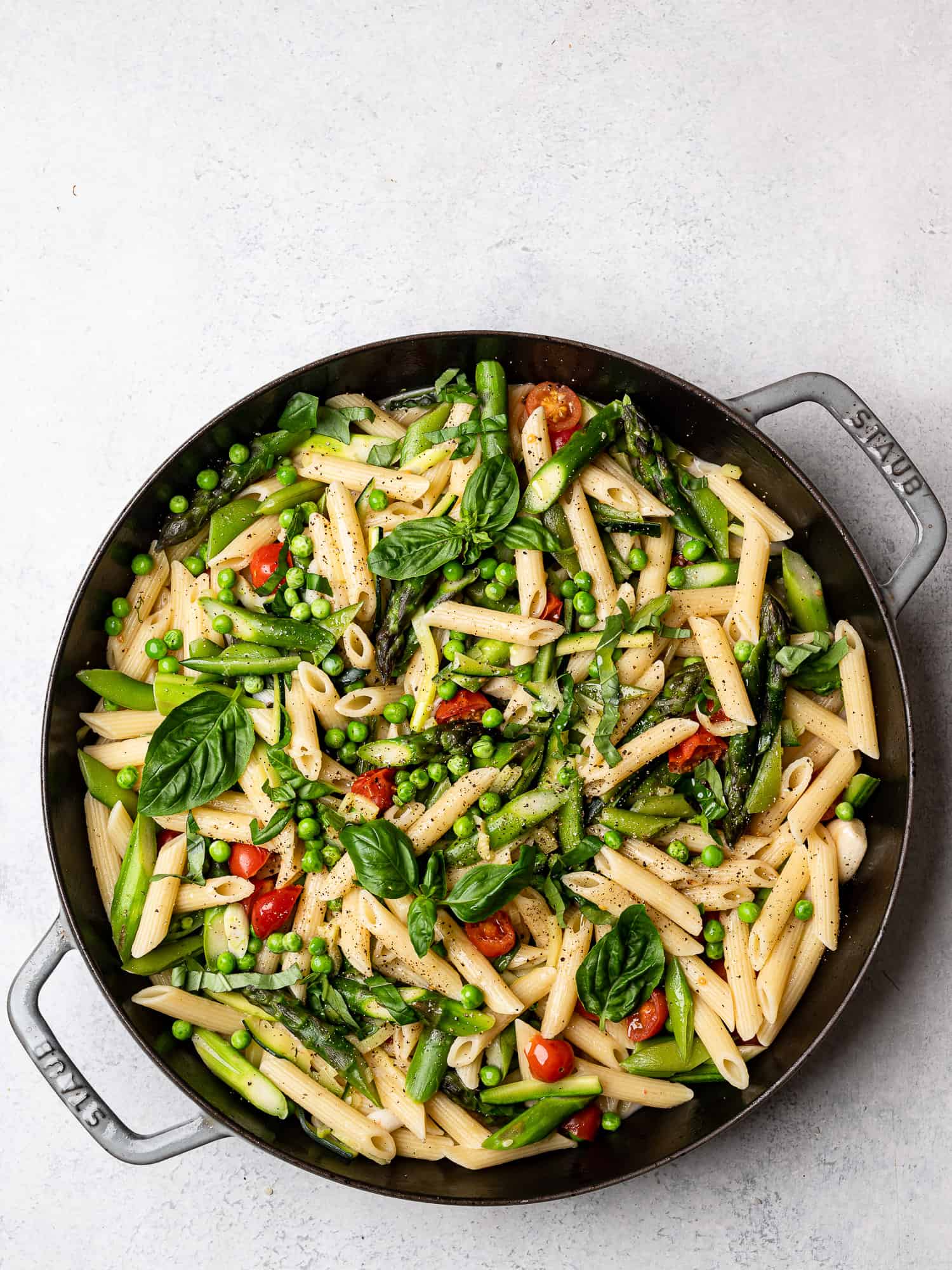
Ingredients
- 4 Tablespoons extra-virgin olive oil
- 4 garlic cloves peeled and smashed gently with the side of a knife
- 8 oz. asparagus woody ends removed and cut into 1-in pieces
- 4 oz. sugar snap peas strings removed, cut on a sharp bias into 1/2-inch slices
- 1 medium zucchini sliced into thin strips
- 1 bunch green onions chopped (about 1 cup)
- 1 cup grape tomatoes halved
- 1 cup fresh or frozen English peas
- 1/4 cup heavy whipping cream (or use 2 tablespoons butter, or more olive oil)
- 1 teaspoon kosher salt plus more to taste
- 1/4 teaspoon Freshly ground pepper plus more to taste
- 1 lb. dried short pasta such as penne, fusilli, gemelli, etc.
- 1/2 cup loosely packed fresh basil leaves thinly sliced
- 2 Tablespoons chopped chives optional
- 2 oz. Parmesan cheese grated (about 1/2 cup) plus more for the table
Instructions
- Bring a large pot of heavily salted water to a boil over high heat.
- While the water is coming to a boil, heat olive oil in a large skillet over medium-high heat. Add garlic and cook until very fragrant and just starting to brown on both sides, about 2 to 3 minutes. Stir in the asparagus, snap peas and zucchini and add a 1/2 cup of the boiling pasta water. Cover skillet and cook until vegetables are barely tender, about 3 minutes. (If your skillet doesn't have a lid, add another 1/4 cup of water and cook for 2 minutes longer).
- Remove the garlic, and stir in the green onions, grape tomatoes, peas, heavy cream, 1 teaspoon salt, and 1/4 teaspoon pepper. Cook for another minute, remove from heat; set aside.
- Meanwhile, cook the pasta just until al dente (about 2 to 3 minutes less than the package instructions). Reserve about 1 cup pasta water, and drain well. Transfer pasta to the skillet and toss to coat, adding a few splashes of pasta water as needed (I usually add about 1/2 cup).
- Remove skillet from heat and stir in Parmigiano-Reggiano, basil and chives (if using). Taste and season with a bit more salt and pepper, if needed. Serve immediately, passing more parmesan around the table.



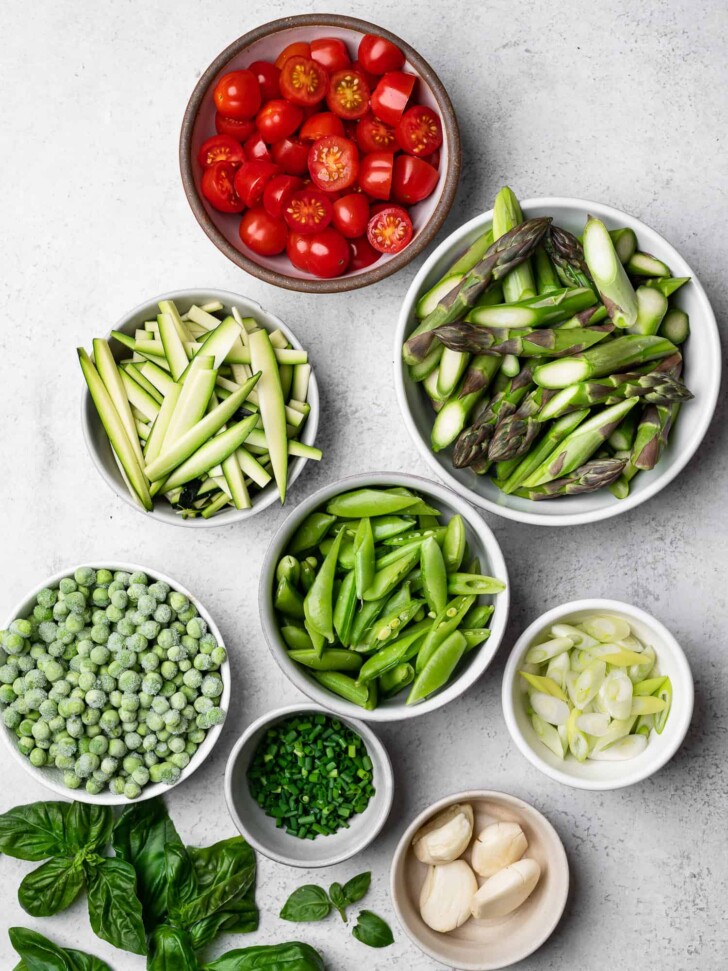



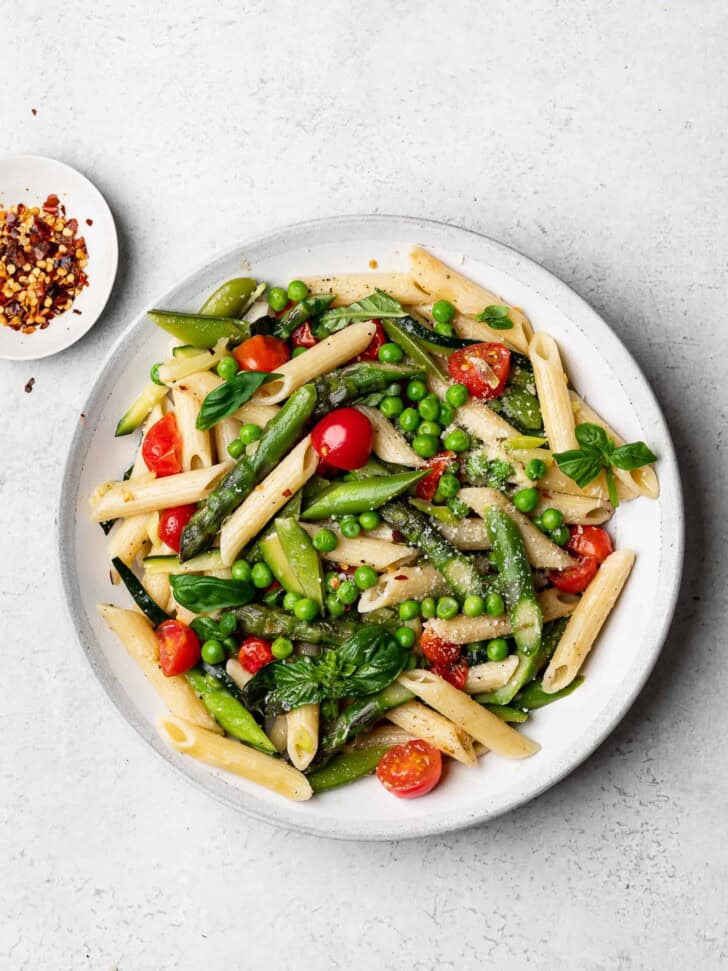
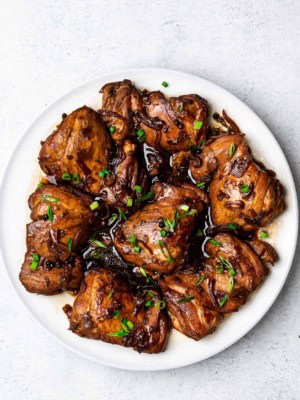
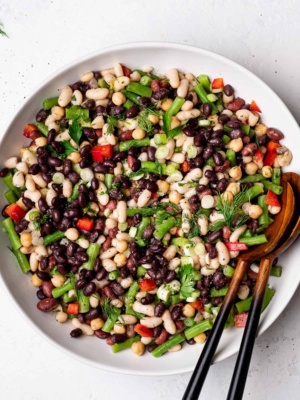

Join the Conversation